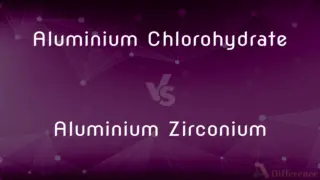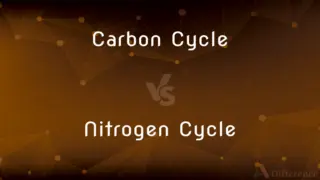Photosystem 1 vs. Photosystem 2 — What's the Difference?
Edited by Tayyaba Rehman — By Fiza Rafique — Published on December 3, 2023
Photosystem 1 (PS1) primarily produces NADPH, while Photosystem 2 (PS2) generates ATP and releases oxygen by splitting water.

Difference Between Photosystem 1 and Photosystem 2
Table of Contents
ADVERTISEMENT
Key Differences
Photosystem 1 and Photosystem 2 are both essential components in the light-dependent reactions of photosynthesis in plants. While they both harness light energy, they have distinct roles and are located in the thylakoid membrane of chloroplasts.
Photosystem 2 operates first in the sequence of events, despite its name. It captures photons, uses their energy to extract electrons from water molecules, leading to the release of oxygen gas. Photosystem 1 follows in the sequence, capturing light energy to drive the production of the energy carrier, NADPH.
The primary pigment in Photosystem 1 is P700 because it absorbs light at a wavelength of 700 nm. On the other hand, Photosystem 2 contains the primary pigment P680, which is most effective at absorbing light at 680 nm.
Photosystem 2 plays a pivotal role in maintaining the proton gradient essential for ATP production in the chloroplast. Photosystem 1, while it doesn't directly facilitate ATP synthesis, is crucial for the production of NADPH, another vital energy carrier for the Calvin cycle.
In essence, both Photosystem 1 and Photosystem 2 are indispensable for the optimal functioning of photosynthesis, with the former focusing on NADPH production and the latter on ATP generation and oxygen release.
ADVERTISEMENT
Comparison Chart
Role in Transcription
Serves as the pattern for mRNA synthesis
Sequence mirrors mRNA, but not directly used
Sequence Similarity
Complementary to the mRNA
Matches mRNA sequence (T for U)
Interaction with RNA Polymerase
Directly read by RNA polymerase
Not actively read
Terminology
Also known as the antisense strand
Often termed the sense strand
Function
Directly guides RNA synthesis
Acts as a reference; involved in DNA replication and repair
Compare with Definitions
Photosystem 1
The DNA strand complementary to the resulting mRNA.
A thymine on the Template Strand will lead to the incorporation of adenine in the mRNA.
Photosystem 2
The DNA strand with a sequence that mirrors the transcribed RNA (except T for U).
If the mRNA sequence is 5'-AUGC-3', the Coding Strand of the DNA will be 5'-ATGC-3'.
Photosystem 1
The DNA strand used as a blueprint for RNA synthesis.
During transcription, the RNA polymerase binds to the Template Strand to produce mRNA.
Photosystem 2
The DNA strand not used as a template for transcription but essential for replication.
Although not directly involved in RNA synthesis, mutations on the Coding Strand can impact genetic information.
Photosystem 1
The sequence that RNA polymerase reads during transcription.
If the Template Strand sequence is 5'-ATGC-3', the mRNA produced will be 5'-AUGC-3'.
Photosystem 2
The strand opposite to the template in the DNA double helix.
When DNA unzips for transcription, the Coding Strand remains unutilized.
Photosystem 1
The antisense strand of DNA that guides protein construction.
Specific sequences on the Template Strand dictate the order of amino acids in a protein.
Photosystem 2
Often termed the sense strand of DNA.
The Coding Strand is so named because its sequence makes sense in relation to the protein-coding sequence.
Photosystem 1
The strand opposite to the one mirroring the mRNA sequence.
When studying gene sequences, scientists examine the Template Strand to determine the resulting protein sequence.
Photosystem 2
The DNA sequence that reflects the protein-coding information.
Biologists often refer to the Coding Strand when predicting the amino acid sequence of a protein from DNA.
Common Curiosities
What's the main function of the Template Strand?
It serves as the pattern for RNA synthesis during transcription.
Why is the Coding Strand also called the sense strand?
Because its sequence makes "sense" or matches the protein-coding sequence, barring T for U.
Is the Template Strand the same as the antisense strand?
Yes, the Template Strand is often termed the antisense strand.
Do the sequences of the Template and Coding Strands differ significantly?
Yes, they're complementary; if one has adenine (A), the other will have thymine (T), and vice versa.
How does the Coding Strand differ in transcription?
While its sequence mirrors the resultant mRNA, it isn't directly used for RNA synthesis.
Which strand does the RNA polymerase read?
RNA polymerase reads the Template Strand.
What's the relationship between the Template Strand and resultant mRNA?
The mRNA sequence is complementary to the Template Strand.
Does the Coding Strand play a role in protein synthesis?
Not directly; it's the Template Strand that guides mRNA synthesis for protein production.
In terms of functionality, can both strands serve as a template?
In different genes or regions, either strand can serve as the Template Strand, but for a specific gene, only one acts as the template.
Can mutations on the Coding Strand affect genetics?
Yes, because the Coding Strand's sequence is crucial for DNA replication and repair.
Is it accurate to say the Coding Strand "codes" for proteins?
Indirectly; while it reflects the protein-coding sequence, it's the Template Strand that actively guides protein synthesis.
How is the Template Strand determined for a given gene?
It's the strand that's read by RNA polymerase to produce mRNA for that specific gene.
Why is it essential to differentiate between Template and Coding Strands?
Understanding the distinction is crucial for studies in genetics, molecular biology, and biotechnological applications.
Which strand contains thymine that corresponds to uracil in mRNA?
Both strands contain thymine, but it's the Template Strand's thymine that corresponds to mRNA's uracil.
If the Coding Strand has a sequence 5'-ATGC-3', what's the mRNA sequence?
The mRNA sequence would be 5'-AUGC-3'.
Share Your Discovery

Previous Comparison
Aluminium Chlorohydrate vs. Aluminium Zirconium
Next Comparison
Carbon Cycle vs. Nitrogen CycleAuthor Spotlight
Written by
Fiza RafiqueFiza Rafique is a skilled content writer at AskDifference.com, where she meticulously refines and enhances written pieces. Drawing from her vast editorial expertise, Fiza ensures clarity, accuracy, and precision in every article. Passionate about language, she continually seeks to elevate the quality of content for readers worldwide.
Edited by
Tayyaba RehmanTayyaba Rehman is a distinguished writer, currently serving as a primary contributor to askdifference.com. As a researcher in semantics and etymology, Tayyaba's passion for the complexity of languages and their distinctions has found a perfect home on the platform. Tayyaba delves into the intricacies of language, distinguishing between commonly confused words and phrases, thereby providing clarity for readers worldwide.
















































